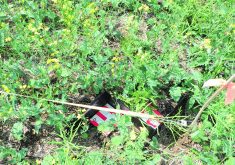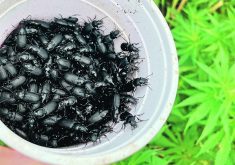Adults are out now, which are ideal targets for baiting; poisoning young animals just takes food away from raptors
PINCHER CREEK, Alta. — Action within the next two weeks will be needed for farmers who want to limit damage this year from Richardson’s ground squirrels, commonly known as gophers.
Phil Merrill, Alberta Agriculture’s pest specialist, told those at an April 8 agricultural services meeting that the narrow treatment window relates to the rodents’ life cycle.
Adults are out now, which makes it the ideal time to kill mature animals. This year’s youngsters will emerge around the beginning of May.
“If you don’t get your poisoning done by the first of May, you’re baiting little ones, and a good baiting program will never get more than 80 percent of your gophers,” Merrill said.
Read Also

Canadian Food Inspection Agency red tape changes a first step: agriculture
Farm groups say they’re happy to see action on Canada’s federal regulatory red tape, but there’s still a lot of streamlining left to be done
“Eighty percent of the young males will die before the next season, and 50 percent of the juvenile females will die before the next season. Basically they’re food for predators.
“So if you’re killing a lot of juveniles in June, you’re just taking food away from raptors. You’re not knocking that population down.”
[yop_poll id=”41″]
Mature gophers go to ground in mid-July, so baiting after that will have limited results. However, there is still merit in taking action if young animals are damaging crops, he said.
Gophers made an early appearance this year because of warm conditions across most of Alberta.
“I think I saw my first one (this season) on Feb. 10,” said Merrill.
The early warmth also brought early sprouting of the green stuff gophers love, and that will affect control efforts.
“Baiting this year is not going to be as successful as maybe some years,” he said.
Strychnine-treated oats are the favoured bait and will work if they are put out before more tasty food options are available. However, gophers might choose new green shoots of growth over baited oats this year, which will reduce control.
Merrill said oats remain the best bet for strychnine-treated bait, but farmers should use wheat in fields with wheat stubble and barley in fields with barley stubble.
A two percent liquid concentrate strychnine is available from agricultural fieldmen in the province. Less than five grams of strychnine, or about the amount on three to five oat kernels, is enough to kill.
However, animals that eat gophers that are killed with strychnine can also die. Merrill said studies show most gophers baited with the poison will die in their holes, but not all of them.
Strychnine works within seconds, so gophers that eat bait far from their hole will die before returning home.
Rozol, an anticoagulant, is also available for gopher control, said Merrill.
Death is slower than with strychnine, and the rodent must eat 50 grams for a lethal dose.
“It’s an excellent product, but you want to make sure that you give him enough.”
Merrill said there is risk to raptors and coyotes that eat gophers killed with an anticoagulant product. It takes days for the gophers to die and while doing so, they become slow and sick.
Hawks, other raptors and coyotes can then make a heavy diet of dying gophers, thus ingesting a lethal dose themselves.
Ramik Green, another anticoagulant, is new on the market, said Merrill. It kills gophers at a lower dose but is available only in a round pellet, which isn’t as attractive to gophers.
Other controls include phostoxin, a gas that asphyxiates gophers in their holes. Its use requires a written control program and rodent control certification.
Merrill also listed RoCon as a control option.
“It’s a good product if you’ve got lots of money and time,” he said.
The product is the same foam used in markers for field work. It is pumped down gopher holes and drowns the rodents.
It requires specialized equipment and soft water to be effective.
Contact barb.glen@producer.com
















